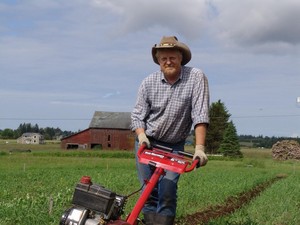14 May Fri 2010
Planting Tomatoes Using Poker Logic
Yesterday (May 13th) I planted 152 tomato plants. Too early you say? I agree, especially since I didn't plant tomatoes until May 23rd last year and May 26th in 2008. However, this was a good play using pot odds, one of the most important strategies in poker. [Disclaimer: I managed to eke out a living playing poker three times in the past and I also worked for a casino in Lake Tahoe, so I see the game from both sides of the table.]
In pot odds, you look at the amount you have to put into the pot and what percentage of the total pot your bet will be. You then quickly calculate the percentage of a favorable card coming up. If the betting percentage is lower than the drawing percentage, then it is to your advantage to make the bet. So, if you are playing Hold 'em (the most popular game right now), you have two cards in your hand and the face-up cards on the table are common to all players. Now, let's suppose you have four cards to a flush, with two of them in your hand and two on the table out of four. For the fifth (and last) card on the table, you have 9 (i.e. 13-4=9) chances out of the remaining 46 (i.e. 52-6=46) cards in the deck or a 19.6% chance of getting a suited card that will fill out your flush. If you can put in a bet that is less than 19% of the pot, you should make the bet. So, if the pot is at $100 and you can make a $10 bet (i.e. 10% of the pot) to see the final card, you have a positive expecation of 9%. Of course, implicit in this strategy is the paradigm of life as one long poker game, because a positive expectation becomes more powerful the longer you play. Long-term positive expectation is how Las Vegas exists, with all the fancy lights, bells and whistles and glamorous lifestyles (hah! - parts of town are quite grubby).
So, yesterday I made a calculated risk based on the concept of pot odds. I had several variables: 1) relatively warm days at the moment, 2) expected rain for several days starting Sunday, 3) the unreliability of the weather forecasts, (Yes, this is a variable too!) 3) tomatoes that are well-hardened off and can take the rain as well as being in limbo in their small cells in the tray, 4) potting on a large number of tomato plants would take quite a bit of time and would not necessarily take them out of limbo, 5) plenty of cloches to protect the plants from cooler temps as well as mitigating transplant shock by concentrating some heat and preserving their own transpiration, 6) a purchase of worm castings yesterday for the express purpose of giving the tomato plants a quick pick-me-up, 7) extra potassium in my fertilizer mix to give the Solanums (both tomatoes and potatoes are in the genus Solanum) a quick boost, and finally 8) I have far more healthy tomato starts than I need. This last variable is the most important, of course, but all the rest of the variables have their weighted importance - even though I cannot calculate precise percentages for each variable.
I should also mention that doing an actual quantitative analysis of these variables would require multivariate statistics, principle components analysis for example, and it really is not needed, since I clearly have the pot odds in my favor. To wit, I have much more to gain from this bet than the small amount of labor and plants I put into it. [Since I am feeding the soil, the fertilizer and worm castings will still go towards feeding the soil if my starts are rained out, so there is no downside to the fertilizer I put down.] So, it was not a no-brainer yesterday, BUT it was a good bet. If the rain next week sets the plants back or provides conditions ripe for early blight, I lose but I lose very little. If the plants get an earlier start, I gain a lot.
There are two things in life that are really important: true love and home-grown tomatoes.

